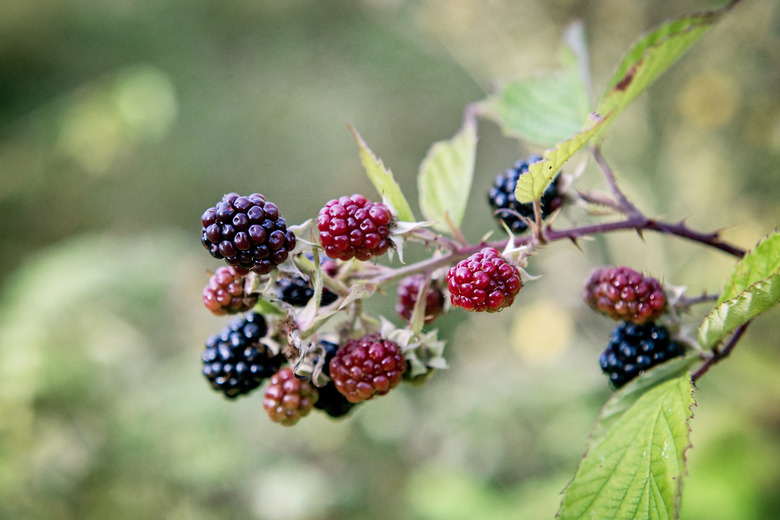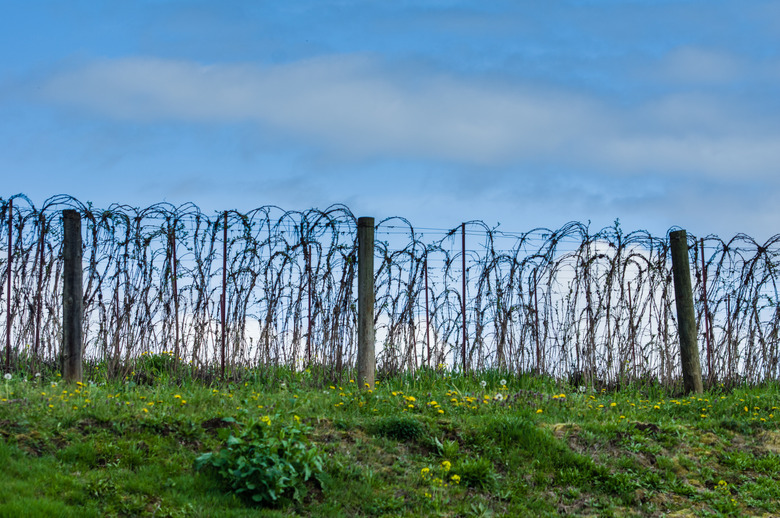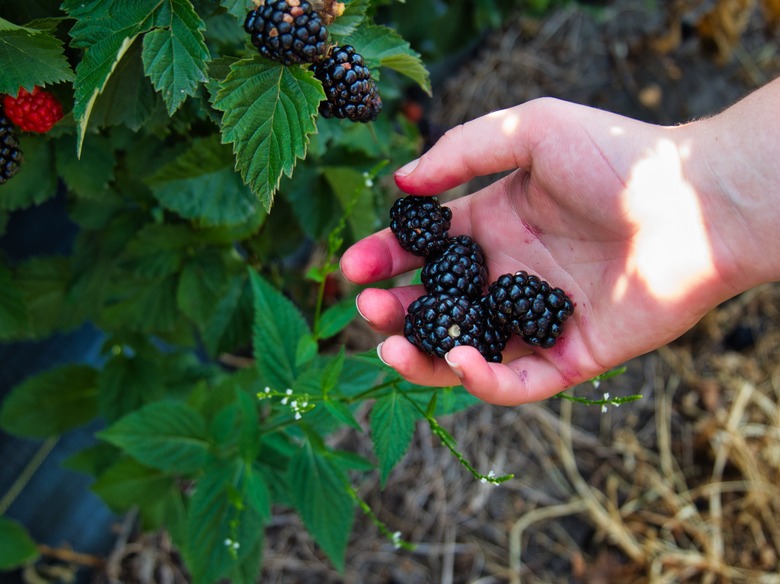How To Take Care Of Wild Blackberries
Caring for a wild blackberry plant comes down to controlling its spread and improving its fruiting and appearance.
Wild blackberry varieties such as the Himalayan blackberry (Rubus armeniacus) and cutleaf blackberry (Rubus laciniatus) grow well throughout U.S. Department of Agriculture plant hardiness zones 3 to 9, where they will aggressively spread if not cared for and properly maintained.
Tip
Avoid actually propagating or transplanting wild blackberries because of their invasive nature. If you want to expand your blackberry patch, purchase cultivated blackberries from a nursery, instead.
Wild blackberries require the same type of care as their cultivated relatives, but they will never produce the same quality of fruit as named varieties. However, wild blackberry brambles can be an asset in your landscape rather than a liability if they are cared for and maintained.
Training Wild Blackberry Canes
Two of the most important aspects of caring for wild blackberries is maintaining their size and providing support for their canes, which will keep the plant under control while also making it easier to harvest berries in late summer.
Warning
Wear gloves, long sleeves and goggles when pruning and trellising wild blackberries to help prevent injury. And don't forget to wipe down your pruning shears with disinfectant before pruning to prevent the spread of disease.
Pruning Wild Blackberries
Pruning wild blackberries will not only improve the appearance and overall health of the bramble, it will also improve their fruiting by redirecting energy back toward the roots. When and how a wild blackberry is pruned depends on whether it is a trailing, erect or semi-erect variety.
Pruning Trailing Blackberries
* Prune trailing blackberries in autumn.
- Cut back the old fruiting canes to the base.
- Trellis the younger canes for next year so they will be easier to harvest from.
- Prune off all suckers as they appear.
Pruning Erect & Semi-Erect Blackberries
* Prune erect blackberries in summer.
- Remove 2 inches from the tip of each fruiting cane once they reach 4 feet in height, which will encourage branching.
- Remove the old fruiting canes in winter.
- Prune off all suckers as they appear.
Trellising Wild Blackberries
Erect and semi-erect wild blackberry varieties are self-supporting, while trailing varieties must be trellised to keep them under control. Trellising will help lift the canes off the ground and provide the whole plant with a manageable shape and structure.
- Install a two-wire trellis lengthwise atop the bramble with the top wire 5 feet above the ground and the second wire 18 inches below the top.
- Spiral the young canes around the wire and secure them with jute string.
Caring for Wild Blackberries
Wild blackberries thrive on neglect, but they will perform better in a cultivated space such as a garden if they are provided with regular care. Watering and light feeding will not only help prevent disease, it will also help the plant bear more, better-quality fruit.
Watering Wild Blackberries
Unless wild blackberries are growing near a year-round water source such as a creek or pond, they will need to be watered. Provide 1 inch of water each week with a little extra during hot, dry conditions. Water only when the soil feels dry below the surface, because soggy soil can create ideal conditions for fungal and bacterial disease. Don't water during the winter months.
Tip
Spread a 3-inch-thick layer of straw mulch under and around wild blackberry brambles to hold moisture in the soil.
Feeding Wild Blackberries
Wild blackberries will produce plumper, better quality fruit if given a light application of fertilizer in early spring. Use balanced fertilizer such as 8-8-8 or 10-10-10 fertilizer and apply it at a rate of 5 pounds per 100 feet of row length. Sprinkle the fertilizer on the soil around the base of the plant and try not to get any on the foliage.
Troubleshooting Wild Blackberry Problems
Badly overgrown wild blackberries can pose a hazard by invading the surrounding landscape and providing shelter for pests such as insects and rodents. Rejuvenation pruning will help to make way for fresh new growth while eliminating places where pests hide.
Rejuvenating Wild Blackberries
The first step in rejuvenating a stand of wild blackberries is to mow it back to ground level. Most home lawn mowers will not perform well when cutting through the dense, weedy canes, so it is best to use a tractor with a brush rake, if possible.
Cutting off the canes at ground level will not eliminate the roots and suckers that make wild blackberry varieties invasive, so you will need to dig up the suckers to control their spread.
- Remove 1/3 of the weakest canes the year after mowing the bramble, then repeat this every year for three years.
- Continue mowing and pulling up suckers from around the main canes.
- Spread landscaping cloth around the base of the bramble and cover it with a 3-inch-thick layer of wood chip mulch.
Grazing goats are highly effective at controlling the spread of wild blackberries—just be sure to fence off the main part of the bramble or the goats will eat that, too!
Cutting back wild blackberries to rejuvenate them will also eliminate the places where pests hide, although you will need to regularly thin the canes to maintain your progress. Cut out any crossed canes at the base using sharp, sturdy pruning shears—and be sure to wear protective gear such as goggles and gloves.


